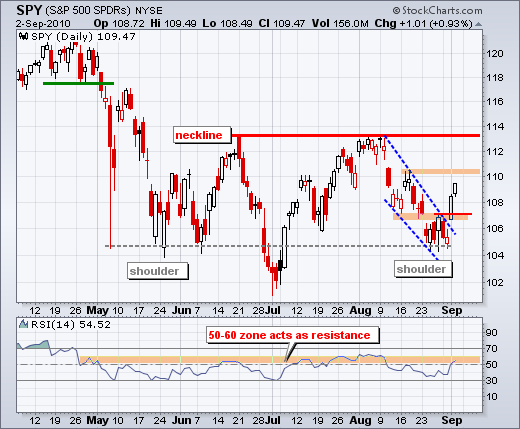Setting first resistance for SPY
There is not much change on the daily chart. SPY held above its July low and found support near the May-June lows. With a channel breakout, the ETF forged a reaction low and the inverse head-and-shoulders becomes a possibility. Neckline resistance resides around 113 and this is the next big test. At this point, the gap and channel breakout are holding with no signs of weakness. RSI moved into the 50-60 zone, which could act as resistance as the ETF becomes short-term overbought.

The 60-minute chart reveals a resistance zone around 110-111. Broken support, the August 11th gap and the mid August reaction high mark this resistance zone. SPY followed through with further gains above 109 on Thursday and we could see a surge into this resistance zone with a positive reaction to today's economic reports. On the support side, broken resistance around 107 turns into the first support zone. RSI support is set at the 40-50 zone. The uptrend is unchallenged as long as both hold.

Today is the big day with ISM Services (consensus 53) and non-farm payrolls (consensus -80,000). The market reacted positively to positive economic news this week. This is a, well, positive trend. Today's employment report is being billed as the biggie. Frankly, I would put more emphasis on the ISM Services Index. Anything above 50 indicates economic expansion and anything above 53 would be very positive.
Key Economic Reports:
Fri - Sep 03 - 08:30 - Employment Report
Fri - Sep 03 - 10:00 - ISM Services
Charts of Interest: Tuesday and Thursday.
This commentary and charts-of-interest are designed to stimulate thinking. This analysis is not a recommendation to buy, sell, hold or sell short any security (stock ETF or otherwise). We all need to think for ourselves when it comes to trading our own accounts. First, it is the only way to really learn. Second, we are the only ones responsible for our decisions. Think of these charts as food for further analysis. Before making a trade, it is important to have a plan. Plan the trade and trade the plan. Among other things, this includes setting a trigger level, a target area and a stop-loss level. It is also important to plan for three possible price movements: advance, decline or sideways. Have a plan for all three scenarios BEFORE making the trade. Consider possible holding times. And finally, look at overall market conditions and sector/industry performance.







